Apple's iPhone 4: Thoroughly Reviewed
by Brian Klug & Anand Lal Shimpi on June 30, 2010 4:06 AM EST- Posted in
- Smartphones
- Apple
- iPhone 4
- Gadgets
- Mobile
Screen - Retina Display
Right out of the box, the iPhone 4's new 326 PPI, 960x640, 3.5" display is arguably the single most striking change the new iPhone brings. In a word, it's dazzling. Text and high res images look amazingly sharp on the iPhone 4’s retina display. It’s an improvement over the 800 x 480 AMOLED screens that have been shipping on most Android phones. But if you’re comparing it to an iPhone 3GS the difference is huge.
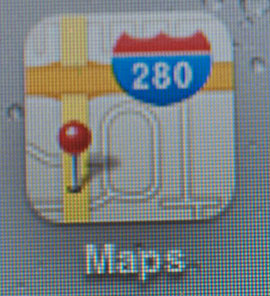 |
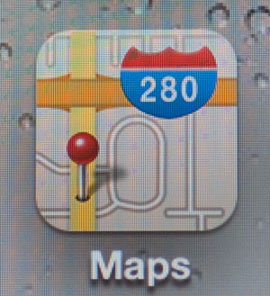 |
|
iPhone 3GS
|
iPhone 4
|

Text on the Google Nexus One

Text on the iPhone 4
The dot pitch is truly remarkable, so much so that Apple makes the claim that their display outresolves the human eye; its advertised ability to do so has earned it a new Apple tradename, "retina display."
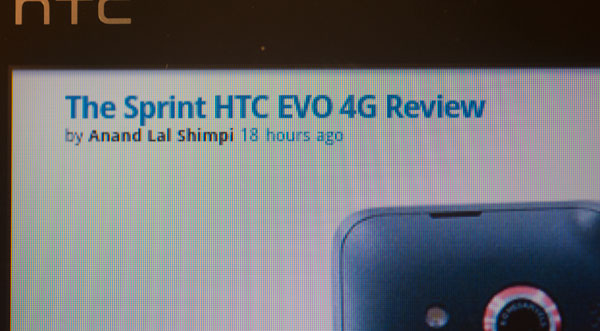
Text on the HTC EVO 4
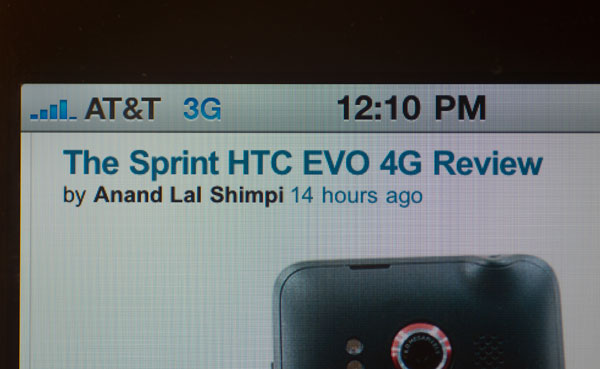
Text on the iPhone 4

AnandTech Logo on the EVO 4G

AnandTech Logo on the iPhone 4
Immediately after hearing Apple's claim that the Retina Display outresolves the human eye, I snapped into optics mode and crunched the numbers, and tweeted that the results were valid.
In the days that followed, there was considerable debate about the validity of Apple's claims. However, nearly all of the debate really just hinged on a debate over angular resolution of the human eye, and a little more over viewing distance. They're both entirely conventions.
As you've probably discovered by now, the human eye resolution can really only be characterized in angular subtense. Hold something closer to your eye, and you can see smaller features better (in theory), move it further away, and you can't make out small spatial details. The minimum angle visible with the human eye is the angle at which features (for the most common definition, a black and white square wave) stop being visible, and are indistinguishable from each other.
Most measures of visual acuity test with this implicitly - the Snellen eye chart's use of the capital "E" is literally a perfect example, which has given rise to a "tumbling E" eye chart. At twenty feet, the capital E subtends 5 minutes of arc, and conveniently has five half cycles of white to black (from top to bottom). So 20/20 implicitly implies an angular resolution of 1 arcminute (1/60 degrees).
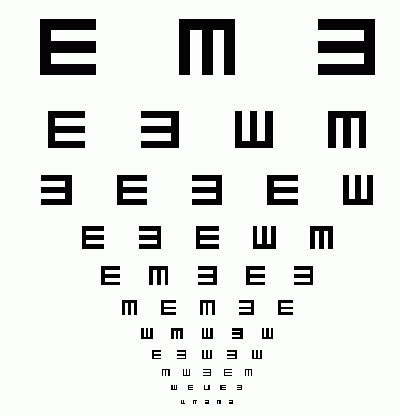
As an Optical Sciences and Engineering undergrad, I've had 1 arcminute drilled into my head more times than I can count as being the "normal" angular resolution of the human eye system. In practice, this is 20/20 vision, which is "normal," yet not perhaps the absolute maximum for human perfection. We can play games of course and argue that a small subset of the population has better than normal uncorrected vision, and thus an angular resolution of below 1 arcminute. I have above average uncorrected vision, which I've measured to be 20/15 on average, giving an angular resolution of approximately 0.75 arcminutes. Of course, the definitions stem from the spacing of cones in the fovea, the highest resolution part of the retina.
The other informational quantity needed to test the Retina Display claims is viewing distance. Again, there's a commonly agreed upon convention - standard viewing distance is considered to be 1 foot. This is another drilled into my brain number tossed around for comfortable viewing and reading. In practice, you can focus on objects much closer to your eye - this is called the near point and is often given as 10 inches, though as you get closer you increase strain aren't likely to keep it here.

Maybe not exactly the limit, but close enough.
Given the two most common standards tossed around, 1 arcminute and 12 inches, do the math out and you'll arrive at around 286 pixels per inch as the limit for eye resolving power, comfortably below the 326 on the Retina Display. Move to 0.75 arcminutes at 12 inches, and it's 382 pixels per inch, higher than the Retina Display. Honestly, I can't see the pixels at 12 inches.
Of course, the real story is even more complicated. Remember how the definition comes with the implicit assumption that we're dealing with a square wave pattern from white to black? That's a factor too - the contrast of the two pixels. Lower the contrast, and the eye's ability to pick out features decreases even more. So far, everything we've talked about has been first order, and without aberrations. Toss in spherical and astigmatism, two aberrations common to the eye system, and eye performance drops way more.
The human eye system is actually pretty poor, and shockingly easy to outresolve. In fact, if you saw the image your eye forms on your retina, you'd likely be appalled; it's your brain that makes the system usable. But at the end of the day, Apple's claims that the display outresolves the human eye are good enough for us.










270 Comments
View All Comments
Mike Wadner - Saturday, July 3, 2010 - link
Well then you're in pretty bad shape. Anyone who considers Microsoft not far behind Apple has their head up their F**KING ass. May be a nice review but I have doubts about their overall knowledge of whats going on out there.websitetrafficchecker - Wednesday, February 5, 2020 - link
If you want to check website traffic for free, visit https://seowebsitetraffic.net/check-website-traffi...jorpoka - Wednesday, June 30, 2010 - link
People seem to making a big deal about the increased ram in iPhone 4, but I think it was almost required.The graphics chip shares memory with the system (just like in previous models) so you have to consider the fact that the screen resolution has increased by 4. How is the system going to deal with the higher resolution grahpics... the 512 MB of ram.
For now not every application on app store uses the updated resolution, but as more and more apps are updated for iOS 4 and the retina display i think the additional 256 MB ram benefit will decrease.
solipsism - Wednesday, June 30, 2010 - link
The surprise wasn't that 512MB wasn't deemed needed, it was simply unexpected after the iPad with a higher resolution, faster processor and generally higher chance for more complex apps to run on the 8x larger display only being shipped with 256MB, like the 3GS, when 512MB was expected. On other words, if the iPad didn't get 512MB RAM, few expected the iPhone 4 being shipped just a couple month later to get it.John Sawyer - Thursday, July 1, 2010 - link
Not higher resolution on the iPad, but more pixels (but we get your meaning).Snotling - Thursday, July 1, 2010 - link
that's the point I'm trying to make since the iPad's release... it was not a planned product, it was ruched out just so they would not be assassinated by the press and the fanatics, my full conspiracy theory is on my blog:http://cyberpeste.blogspot.com/2010/01/letter-to-s...
Now with the iPhone 4, we see what Apple was actually working on before rushing out the iPad and its a very good product. superior in every way to the iPad.
tkoyah - Sunday, July 4, 2010 - link
Um, the iPad wasn't rushed. The iPad project actually pre-dated that of the iPhone. But when it became aparent that this would be the perfect interface for a Phone, the iPhone project began, and was given a higher priority.I expect this first iPad wasn't given more RAM: a) to keep the price-point under $500 b) because there was no pre-existing iPad software, so having less memory available wouldn't break any apps.
tipoo - Wednesday, June 30, 2010 - link
The big deal is that the iPad, their tablet, has half the RAM of the phone they released shortly after. With a bigger screen and more pixels, people naturally would have expected the iPad to have the technological edge, but with only half the RAM of the iPhone that is not the case.AMDJunkie - Wednesday, June 30, 2010 - link
Begins after this post.Zokudu - Wednesday, June 30, 2010 - link
Wonderfully written article I love this line of high end smartphone articles you guys have been releasing. I love the quality of the writing at Anandtech.Just a few questions I have.
Doesn't AT&T have a 5 year exclusivity deal for the iPhone meaning they would still have around 2 years remaining before an opposing carrier could offer the device?
Also several of my friends with iPhones both 3G and 3GS constantly complained about AT&Ts coverage within New York and blamed the carrier. However several of them have gotten iPhone 4's and are reported fewer dropped calls if any at all. I have been using a Blackberry on AT&T's network for several years now and have had no issues with their coverage. Do you feel the dropped calls within hot spots such as New York should be blamed on the iPhone itself or the network?
Also where do you feel that Windows Phone 7 fits into the future of smartphones. Do you envision it taking center stage against both iOS4 and Android or falling to the wayside such as webOS ended up doing?
Once again thank you for the wonderful read and keep up the quality work.